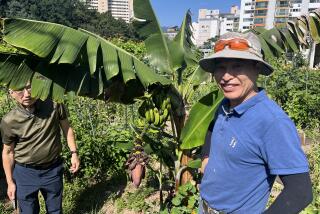Yes, There Are No Bananas
Until last year, there was only one commercial banana plantation in the United States west of the Mississippi River. Now there are none.
At the northern tip of the tiny beach community of La Conchita, Seaside Banana Gardens has closed its palm-thatched gates for good. Its 50,000 trees are being dug up or plowed under.
Doug Richardson, the business’ owner, lost his lease last year. He said he started to miss monthly payments to La Conchita Ranch Co. after a massive mudslide in March 1995 buried many of his trees.
“We lost a quarter-million dollars in production and plants after the dirt came down,” he said.
About 600,000 tons of mud slid down the steep bluffs looming over the town. Homes were destroyed, and county officials warned of the chance for another slide. Even now, some homeowners in La Conchita doubt they’ll ever recoup a fraction of what they put into properties in the quirky seaside haven. The plantation, situated in a microclimate uniquely suited to bananas, never bounced back.
Richardson was given until March 1 to uproot his bananas and move his thousands of potted papayas, mangoes, guavas, coffee plants, sugar cane and other tropical flora.
It hasn’t been easy.
Richardson has had to restore the acreage to the state it was in before he planted his first exotic tree there 12 years ago.
That has meant bulldozing thousands of banana trees, plus chopping down and carting off a eucalyptus windbreak along Highway 101.
The move takes from Ventura County one of its most distinctive tourist attractions.
Over the years, carload after carload of tourists and curious residents would spot the sign for the Seaside Banana Gardens and turn off Highway 101 at La Conchita.
What they discovered was more than bananas a la Chiquita. They found bananas that tasted of chocolate, sweet little Lady Finger bananas, Brazilian bananas, Ice Cream bananas, Cardaba bananas.
The fruit grew in La Conchita thanks to the distinctive weather patterns, between a high cliff and the ocean, which Richardson long had sought.
Warm ocean water radiates heat that slowly rises over the town, mixing with cool coastal air overhead. Heat that accumulates during the day radiates again at night, generally preventing temperatures form dropping below 50 degrees, the minimum for cultivating bananas.
Richardson has sold some of his plants to wholesale nurseries. Many potted plants remain, carted a third of a mile to a lot at the south end of the one-gas-station town.
The newly leased 16 acres won’t be open to the tourists and fruit fanciers who dropped by the old place to sample some 58 varieties of bananas. It will be more of a holding space for Richardson’s nursery stock while he tries to realize yet another dream.
He says he hopes one day to buy the new lot and turn it into a botanical garden of tropical and native plants.
“I’m going to work on getting grants to open the garden on our new site, but it will be years,” he said. “It would be a model demonstration farm for ecological design and education.”
In the meantime, Richardson said, he might go back to retail fruit and vegetable marketing.
“But no matter what, I’ll always feel good about all the small local growers that have come and bought our banana trees to try their hand at them.”
More to Read
Sign up for The Wild
We’ll help you find the best places to hike, bike and run, as well as the perfect silent spots for meditation and yoga.
You may occasionally receive promotional content from the Los Angeles Times.






